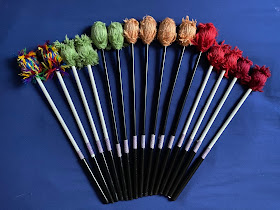In each video, I sing the lyrics, sing the letters while fingering, and then actually play the recorder.
Here is one example video. You can view all these videos here on my classroom webpage.
With most of us forced to teach remotely due to spread of COVID-19, I thought it would a great time to share these videos, as well as a tutorial, in case you would like to use them or create your own.
Recorder Play-Along Video Tutorial
For this tutorial, I use Powerpoint on a Windows laptop and an iPhone/iPad with iMovie.
You can use a macbook or Droid Phone, but the steps may need to be modified slightly.
Part 1: Create Your Backgrounds
1) Use Powerpoint to create a solid black background.
2) Use the Snipping Tool to get screenshots of your music and fingering chart.
3) Save a black space on the side for the video to be inserted later.
4) Save the Powerpoint as jpg so each slide is an individual image.
5) Save those images in Google Drive so they can be opened on an Apple Device phone or ipad and save them to the camera roll.
View this video for a more detailed tutorial.
Part 2: Creating Your Movie
1) Record your video (I use my iPhone).
2) Resize the video to have a square frame. Do this by clicking edit, crop, then the square frame.
3) Open Google Drive to retrieve your backgrounds and save them to your camera roll. Select the file, then select the 3 dots, click "Send a copy", and click "Save image". It should now be on your camera roll.
4) Open iMovie and insert your background.
5) Disable Ken Burns Effect on the image.
6) Reposition the background using pinch, zoom, or one finger move.
7) Click the plus sign in the upper right corner, click on your video, click the 3 dots, and select "Picture In Picture"
8) Click your video in the bottom window to select it. Then click in the top box to reposition your video. You may also pinch to zoom if needed.
9) Click your video in the bottom window and unmute the audio.
10) Click your background image in the bottom window and stretch your image to play the entire length of your video.
11) Save video to camera roll and share your video on your desired platform (Youtube, email, webpage, Facebook, etc.)
View this video for a more detailed tutorial.















